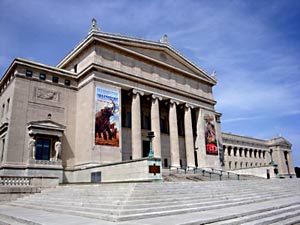By: Sue Robert
From: The Pick and Dop Stick, 10/2010
1st Place — 2011 MWF Features
8th Place — 2011 AFMS Features

Part of my reason for visiting the Field Museum on June 22nd was to check out the exhibit on “Mammoths and Mastodons” so I could write a review of it for The Pick and Dop Stick. Though the “Mammoths and Mastodons” was scheduled to close September 6th, a few comments on the exhibit and other sections of the museum may be of interest. “Mammoths and Mastodons” was an excellent show, up to the Field’s usual high standards. It had been designed to appeal to all ages and levels of knowledge, from the young button pusher to those with a serious interest in the topic. It was a noisy exhibit, not entirely due to the many children’s camp groups trooping through the rooms. The almost constant background sound effects gave visitors the impression that these herds of giants spent much of their time stomping and roaring with an occasional pause for loud crashing fights with their large tusks over a potential mate. Although mastodons and mammoths lived side by side in some areas, they didn’t compete for food because their very different teeth were adapted to eat different parts of the plants. Using modern technology to examine a cross section of the tusks of these animals, scientists were able to study the minute lines that indicated a day’s growth. Mastodons became extinct long before mammoths, the last of whom took refuge on islands off the coast of California and in Siberia and endured until 3700 years ago. There is no clear explanation for what caused the extinction of mammoths or mastodons. Theories include overhunting, disease, and a meteor strike, which rather abruptly changed the climate and the food supply. Thomas Jefferson, who was a serious fossil collector, knew of the existence of mastodons from the discovery of their bones by members of the Lewis and Clark expedition in l803-1804. After the return of the explorers, he sent Clark to Big Bone Lick in Kentucky to procure mastodon bones for him, which he displayed at his home in Monticello.
There is much in the museum to appeal to the interests of CRMS members. 2010 marks the tenth anniversary of the discovery of Sue, the world’s largest and most complete T-Rex skeleton. Two exhibits celebrate a decade of Sue at the Field. “Sue: Waking the T-Rex in 3D” is a 25 minute film in the museum’s new 3D theatre, which tells the story of the discovery, excavation, auctioning, and preparation of this 90% complete skeleton. The film closes with scenes that bring to life Sue and her world of 67 million years ago. “Robo Sue”, right next to the 3D theatre, is an animated exhibit of life-sized dinosaurs in the natural setting in which they lived. Visitors experience nesting triceratops, hungry raptors, the living Sue, and other dinosaurs. Both the 3D film and Robo Sue require an extra ticket for admission.
Other Exhibits:
“Evolving planet”, a permanent exhibit, has great appeal to fossil collectors. It brings to life four billion years of evolution from the dawn of life to our extended human family using fossils, films, models, animation, and hands-on pieces to vividly and clearly tell the story of our evolving planet. Two other not-to-be-missed rooms are the renovated Grainger Gallery and Hall of Gems and the Hubert Hall of Jades at the south end of the second floor. These exhibits feature world class specimens of gems and minerals in beautifully appointed galleries. The most disappointing current feature of the museum was the “Rock-ology” store in the basement. The sign in the store window read, “Bring home your own crystal cave”, and there were several opened Mexican geodes on display, priced at $18-25. I entered the store and asked about the geodes. There was a large bin of unopened Mexican geodes on the floor. The customer was to choose one, purchase it, and the geode would be cracked on site. When I asked about Keokuk geodes, the lone disinterested salesgirl shrugged and mumbled, “Never heard of them.” Skip the Rock-ology store and come to the CRMS Geodefest and Silent Auction instead.
Opening on October 22, 2010, and running until March 6, 2011, is an exhibit entitled simply “Gold”. According to the brief notes in the museum’s brochure, this exhibit explores gold’s “natural beauty, scientific value, and power to shape history”. Based on past special exhibits, I’d say “Gold” is well worth putting on your calendar. Target sponsors free museum admission the second Monday of each month, however, the special exhibits, on gold, Robo Sue, and the 3D films are not included in the general admission ticket. The Field Museum of Natural History is a world class museum and offers much that is focused on our interests. Is it time for you to check it out again?
For permission to reprint this article, contact us at info@chicagorocks.org.

